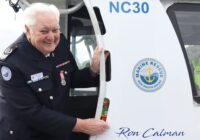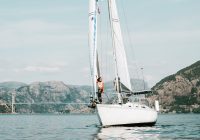Frozen Witness – an Exhibition at the Australian National Maritime Museum – for a limited time only
Frozen Witness: Aurora’s Polar Voyages brings to life the extraordinary story of a remarkable vessel– a timber whaling ship turned Antarctic explorer – whose legacy spans sealing, science, survival, and ultimate sacrifice.
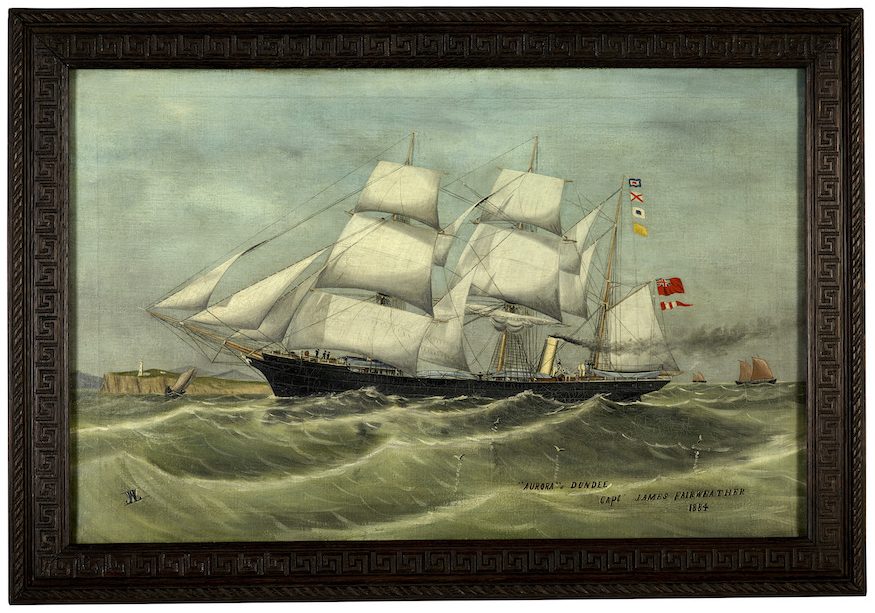
Aurora of Dundee, Captain James Fairweather, 1884, oil on canvas, artist unidentified – ANMM Collection 00050156 Gift from Captain Fairweather’s great-grand children in memory of their father James S Fairweather 1926-2015
Built in 1876 in Dundee, Scotland, the 580-ton SY Aurora was originally designed for Arctic whaling. But the ship’s destiny lay far to the south. Over four decades, Aurora became a silent witness to some of the most dramatic chapters in polar exploration, including the heroic expeditions of Sir Douglas Mawson and Sir Ernest Shackleton.
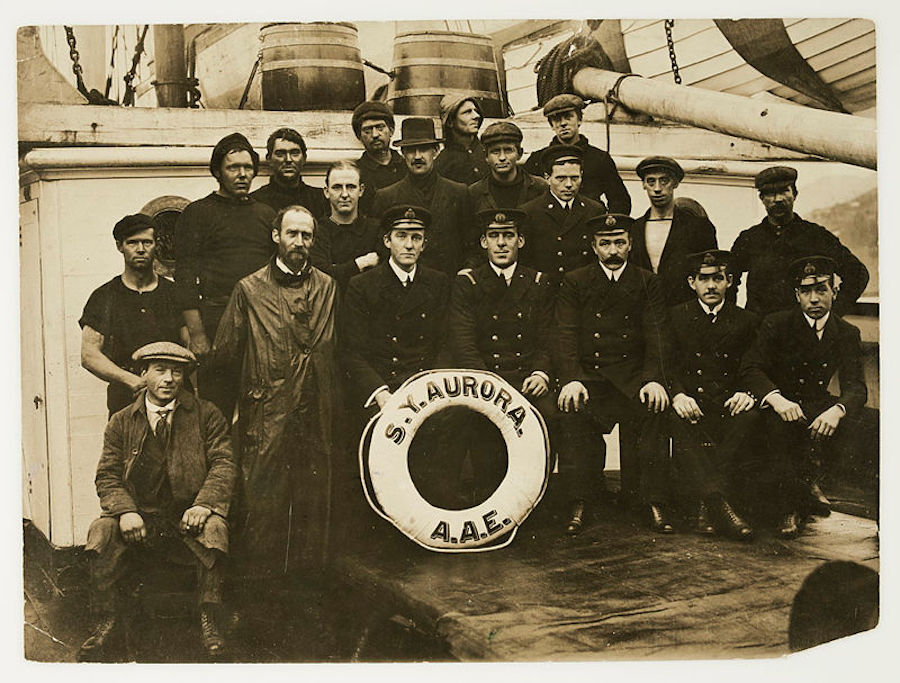
Aurora’s Captain John King Davis, officers and crew, 1912-13, photographer Leslie Hinge – ANMM Collection ANMS1114[001] Gift from Alan Fletcher
A Ship of Many Lives
Aurora spent most of its life in the icy waters of Newfoundland and Greenland in the last decades of the seal and whale industry. One well documented voyage from Dundee in 1884 under Captain James Fairweather returned 28,000 seals for their fur and oil, a catch which foresaw the decline of the industry in the early 20th century.
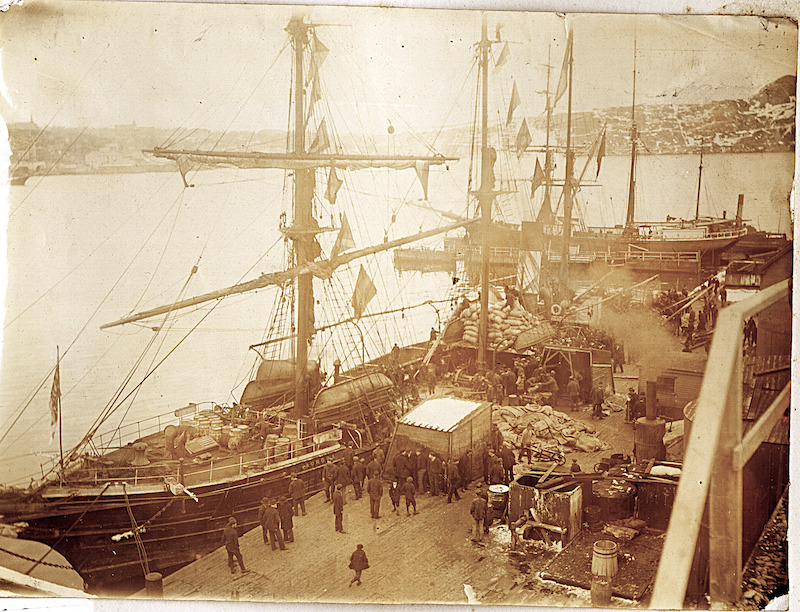
Aurora unloading seal pelts alongside Job Brothers & Co, St John’s, Newfoundland, c1905 – Maritime History Archive, Memorial University, St John’s, Newfoundland, Canada
But in 1911, the ageing vessel was purchased for £6,000 by John King Davis, Australian geologist and Antarctic veteran Sir Douglas Mawson’s Australasian Antarctic Expedition (AAE). Refitted in London and sailed to Hobart, Aurora carried scientists, supplies, and 40 Greenland huskies to the frozen continent.
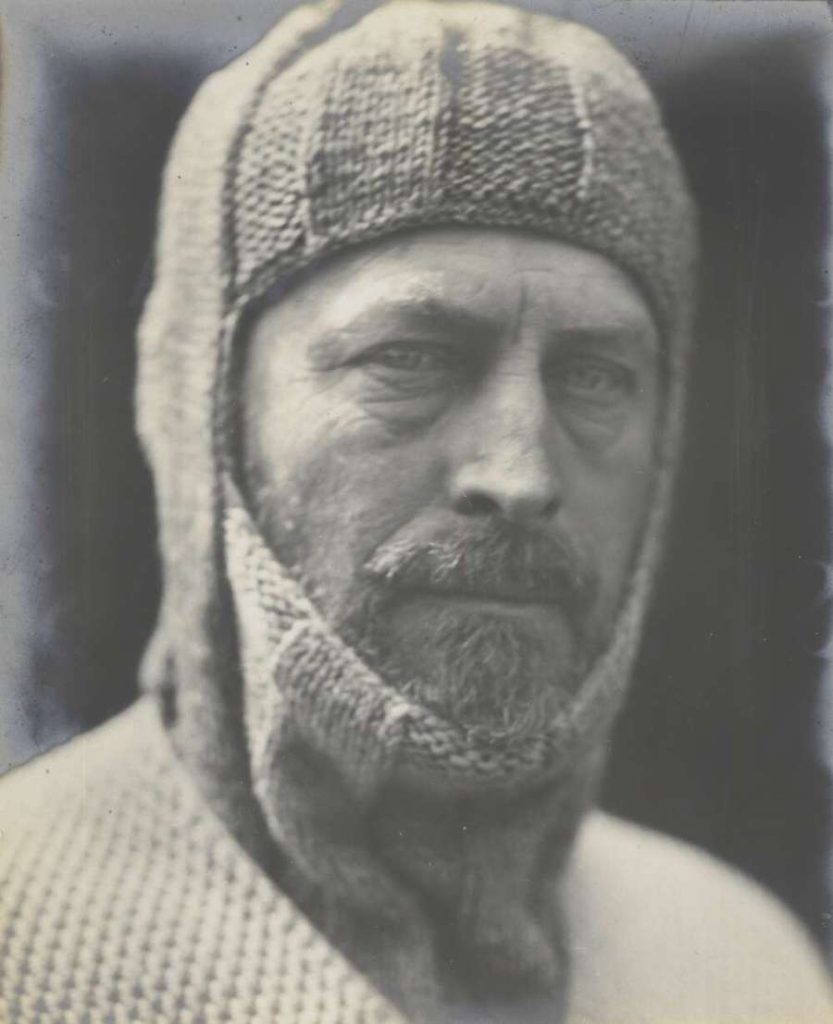
Sir Douglas Mawson during his third Antarctic expedition, the British, Australian and New Zealand Antarctic Research Expedition (BANZARE) of 1929–30, Photographer unknown – National Library of Australia
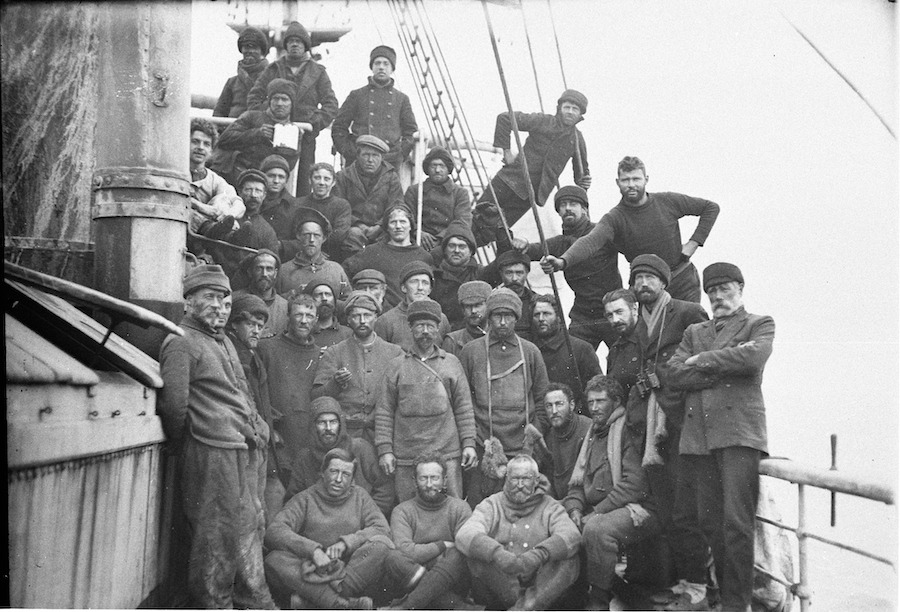
Captain John King Davis with group on SY Aurora after leaving Western Base 1913
Photographer Frank Hurley – State Library of New South Wales
Over three Antarctic voyages, Aurora supported the establishment of bases at Macquarie Island, Commonwealth Bay, and Queen Mary Land. The expedition’s achievements were immense: over 6,400 km of land explored, groundbreaking scientific discoveries, and 22 volumes of research reports. Yet tragedy struck when Mawson’s sledging companions perished, and he famously missed the departing Aurora by mere hours, surviving another harrowing winter before rescue.
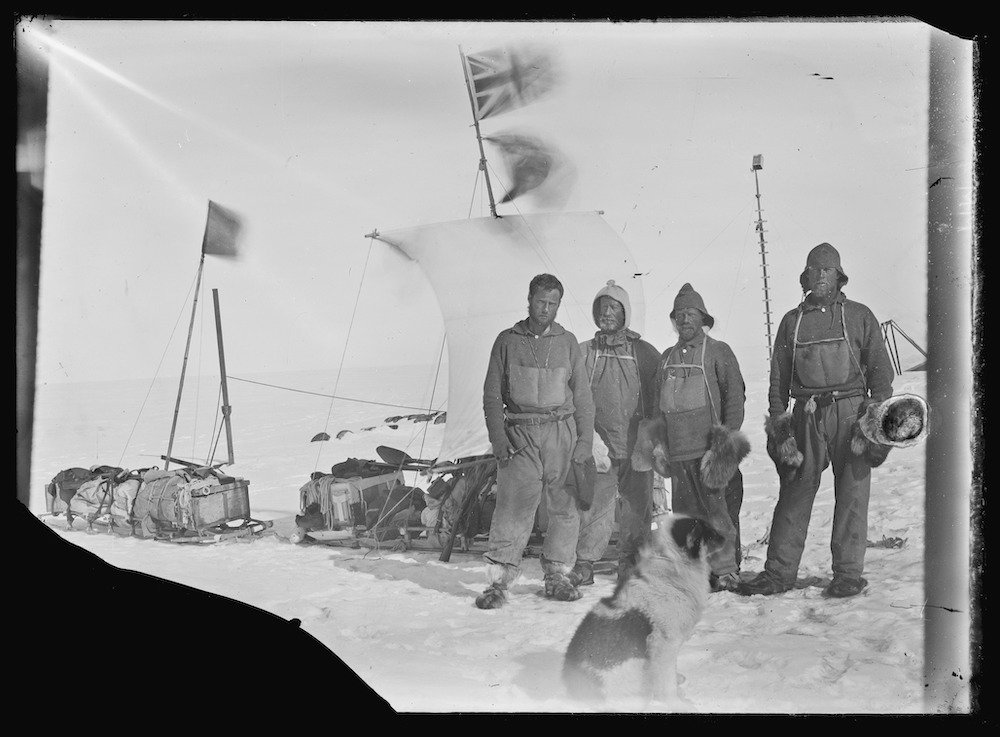
Western base leader Frank Wild’s sledging party on return to the Grottoes, their base hut, 1912, Photographer Morton Henry Moyes – State Library of New South Wales
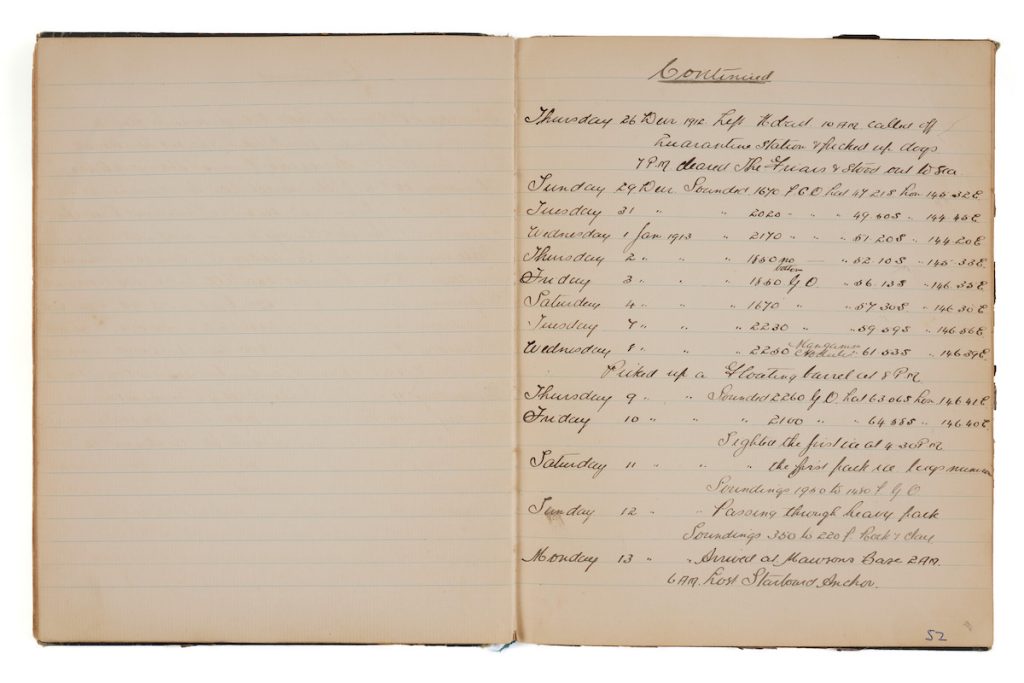
Chief Officer ’Frank’ Frederick D Fletcher’s log diary noting Aurora’s departure leaving main base, Cape Denison, noting Mawson’s return, the loss of Mertz and Ninnis and the necessity to leave Mawson and the six men for another winter due to a blizzard 8–9 February 1913 – Australian National Maritime Museum Collection Gift from Alan Fletcher
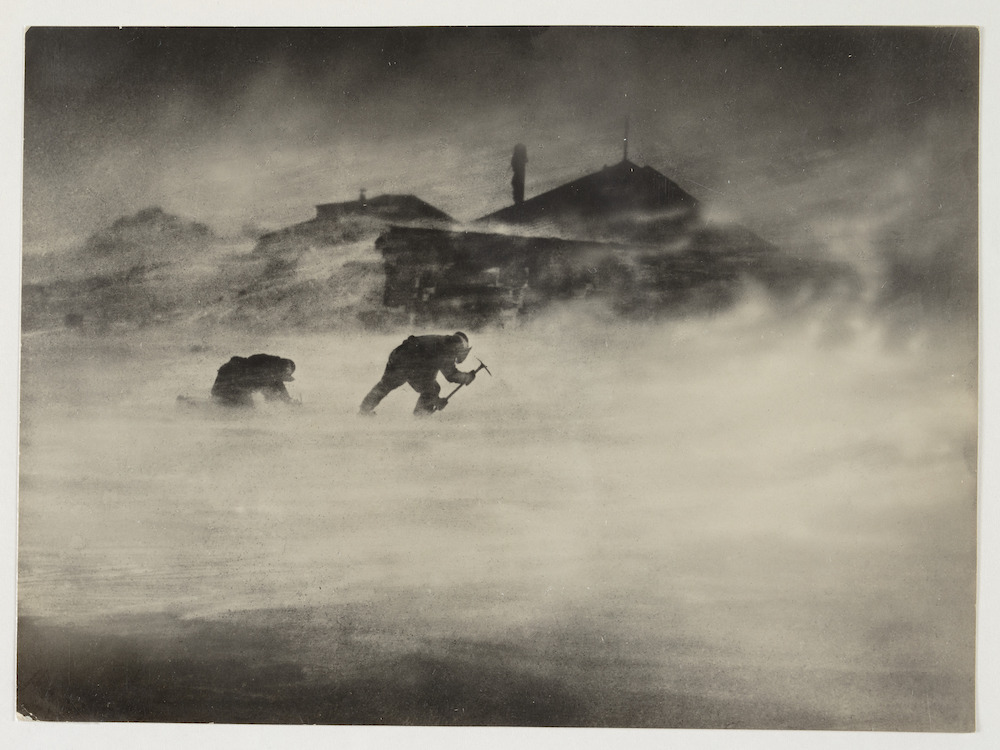
Getting ice for water supply, main base, Cape Denison Station, Adelie Land, 1912-14 – Photographer Frank Hurley
State Library of New South Wales
Shackleton’s Shadow
In 1914, Aurora was again called to duty – this time as the Ross Sea supply ship for Shackleton’s Imperial Trans-Antarctic Expedition. Under Aeneas Mackintosh, the Ross Sea party laid vital depots for a crossing that never came. Famously Shackleton’s Endurance was lost in the Weddell Sea, and on the other side of the continent, Aurora too became trapped in ice, drifting over 1,200 miles for nine months.
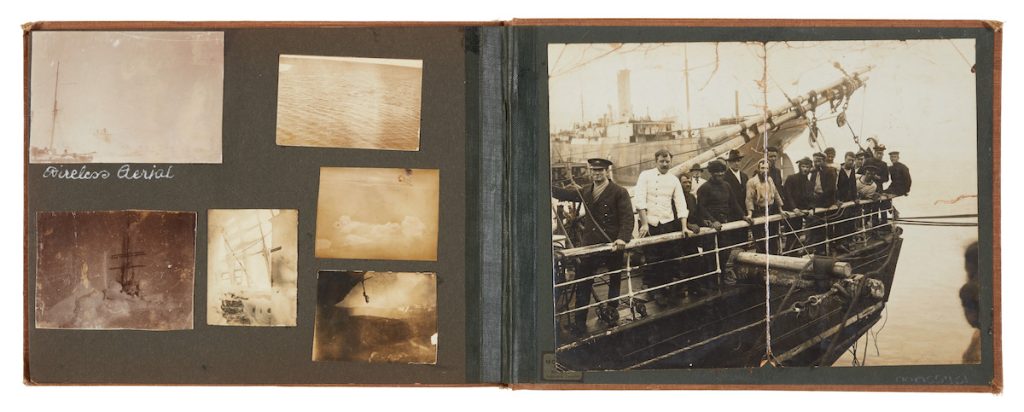
Joseph Stenhouse (far left) and men on Aurora after on arrival in Port Chalmers, New Zealand after their entrapment and drift, 3 April 1916, Photographer unidentified – Australian National Maritime Museum Collection 00055431, Sir Lionel Hooke Album
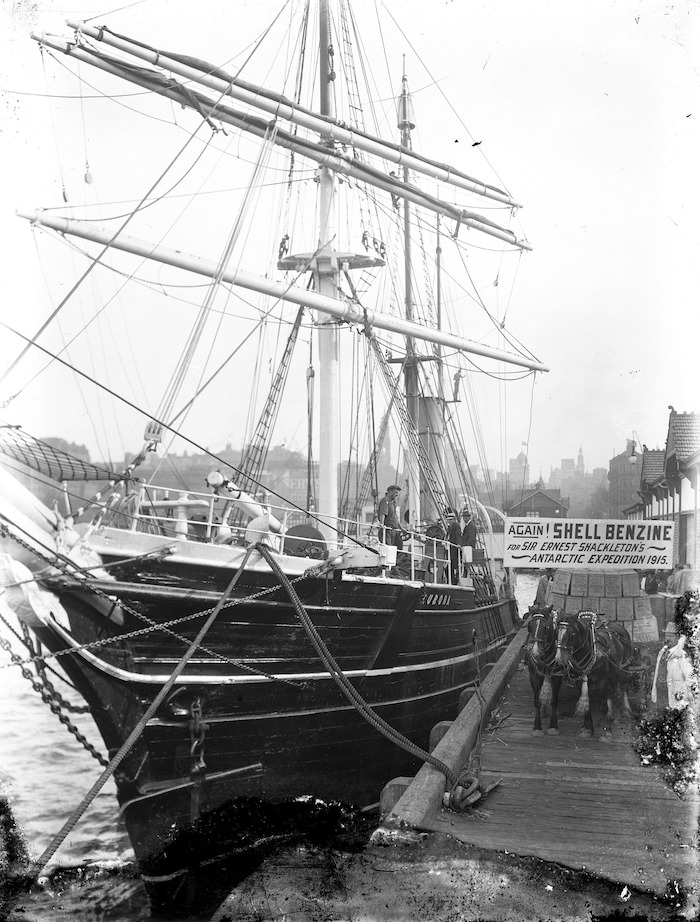
Aurora in Sydney 1914, where Ross Sea Party leader Aeneas Mackintosh gathered crew, equipment and supplies, Photographer William Hall Studio – Australian National Maritime Museum Collection ANMS1092[163]
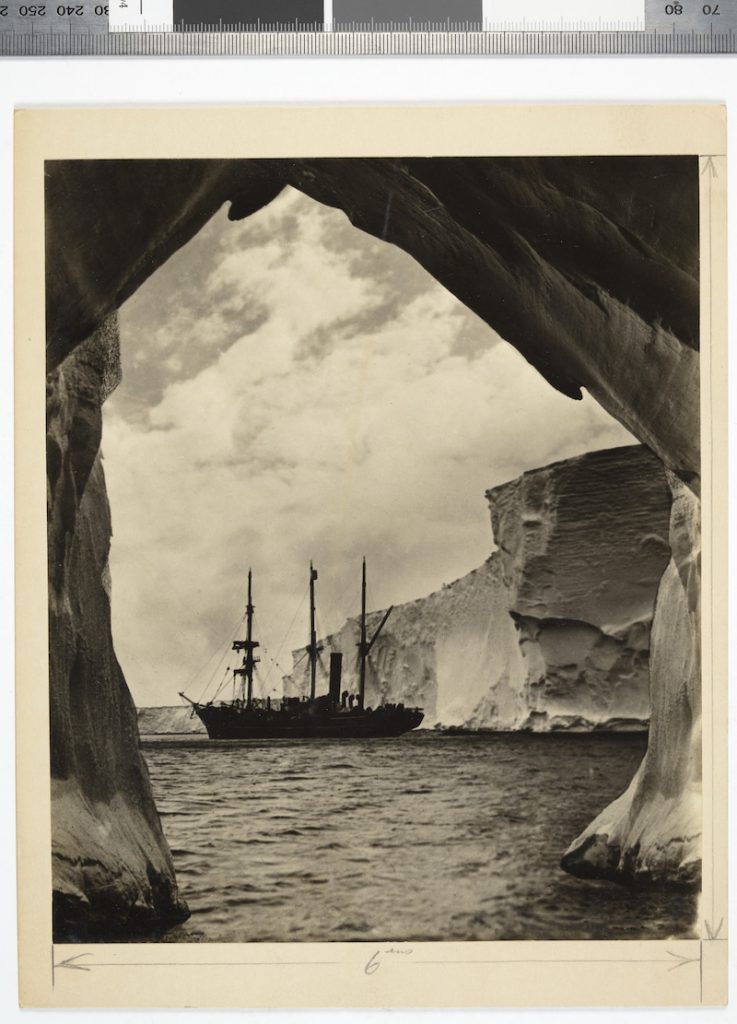
The sheer ice wall of the Mertz Glacier Tongue, Commonwealth Bay, with SY Aurora, photographer Frank Hurley 1911–13 – State Library of New South Wales
Miraculously, Aurora survived. Under First Officer Joseph Stenhouse, the ship reached New Zealand in 1916. After refitting, the veteran polar ship returned to Antarctica to rescue the stranded sledging party, bringing seven survivors home in early 1917. Three of the expedition’s men including its leader Aeneas Mackintosh had perished on the ice, laying depots for the crossing party who would never arrive.
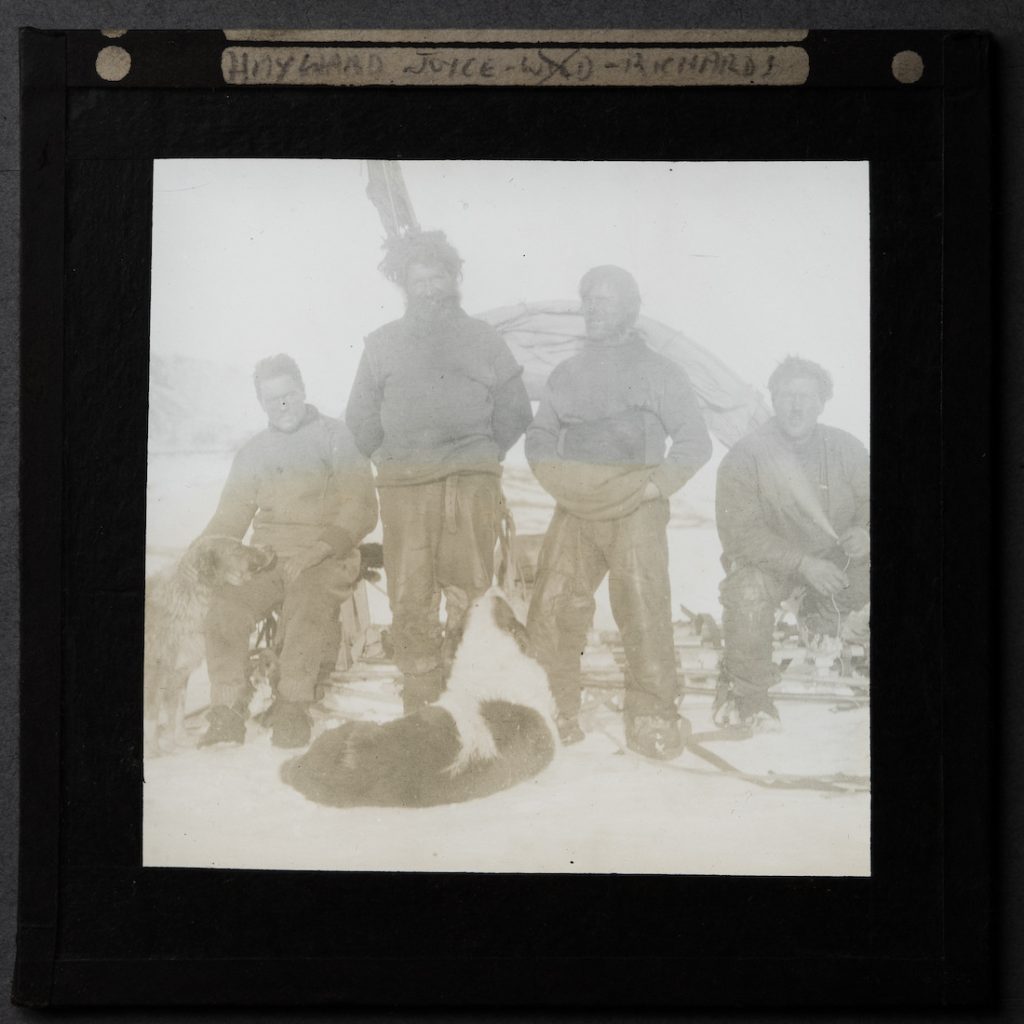
Mount Hope sledging party, from left : Victor Hayward (who died on the expedition), Ernest Joyce, Ernest Wild and Dick Richards, with dogs Gunner and Towser 1915-16 – Canterbury Museum, E E M Joyce Collection
A Mysterious End
On 20 June 1917, Aurora departed Newcastle, Australia, bound for Chile with a cargo of coal. The vessel did not make it. Theories abound – a mine, a collision, a storm – but the truth remains unknown. Only one relic was ever found: a lifebuoy, recovered months later, bearing the ghost lettering of her Antarctic voyages.
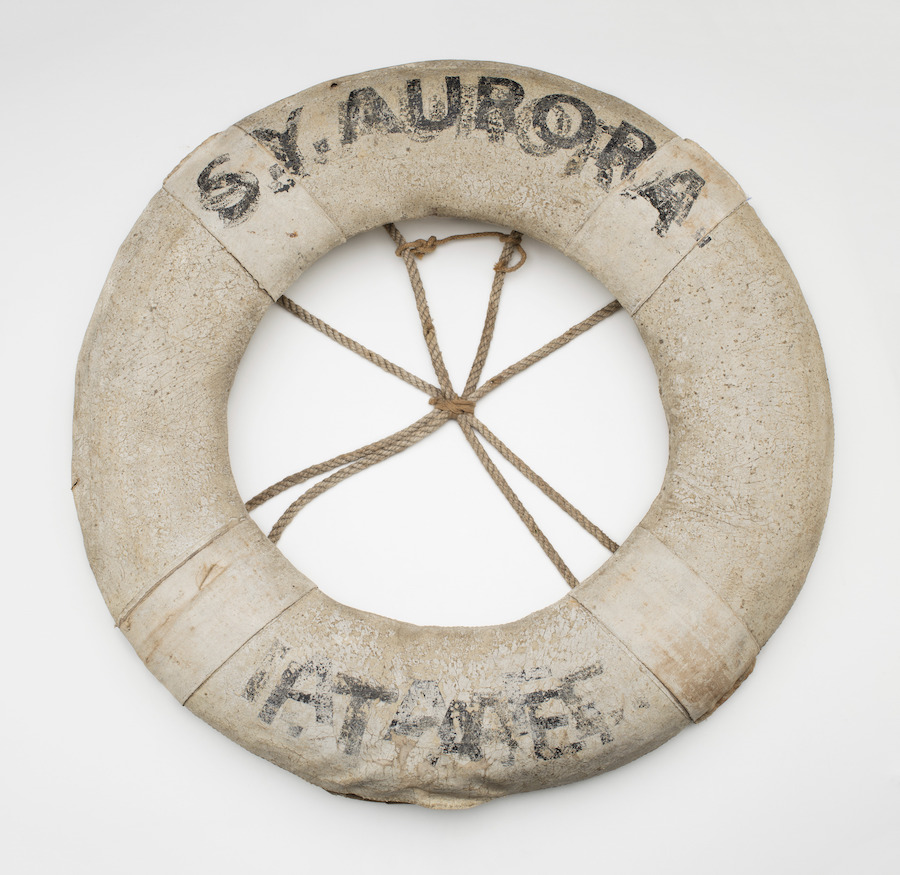
SY Aurora lifebuoy plucked from waters off the north coast on NSW six months after the ship had left Newcastle with a cargo of coal for Chile in June 1917 – ANMM Collection Gift from Mr John Hooke CBE, in memory of Sir Lionel Hooke, wireless operator SY Aurora 1914–16
This lifebuoy, now a centrepiece of the Frozen Witness exhibition, is more than a maritime artifact. It is a symbol of the courage, sacrifice, and scientific ambition that defined an era of exploration. It also honours the 21 souls lost with Aurora – including its captain – whose story continues to inspire.
A Legacy Preserved
In the 1930s, the lifebuoy was presented to Sir Lionel Hooke, who had been a young wireless operator aboard Aurora during the Ross Sea expedition. His technical brilliance helped signal the ship’s survival during its ice-bound ordeal. Hooke would go on to lead Amalgamated Wireless Australasia (AWA) but never forgot the ship that shaped his early career.
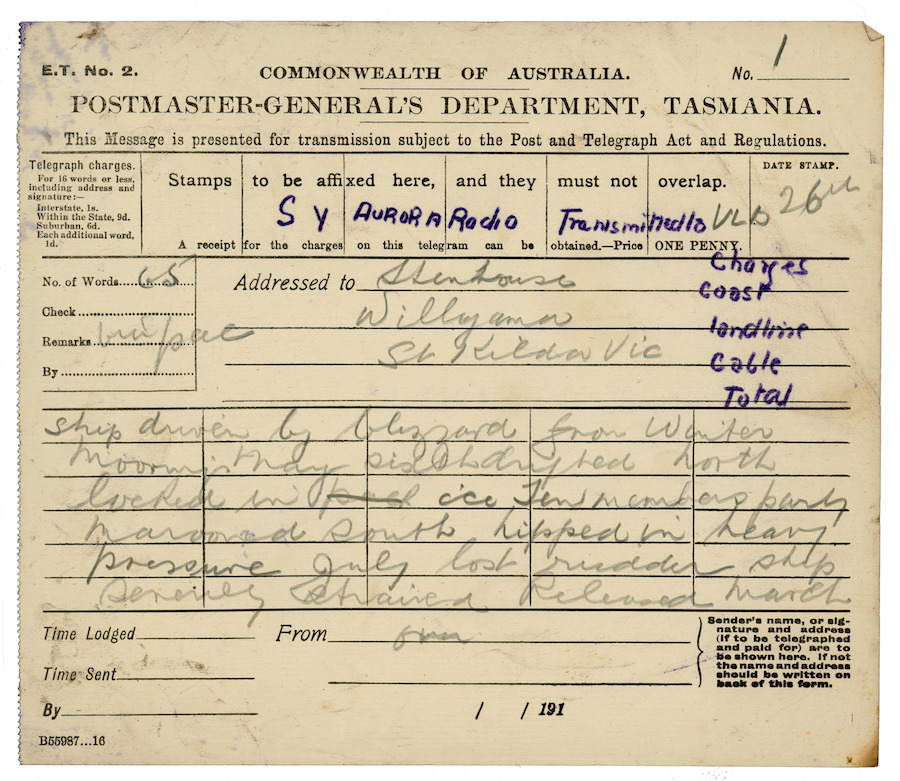
‘Ship driven by blizzard…’ wireless telegram sent by Lionel Hooke from Aurora’s commander Joseph Stenhouse to family in Melbourne signalling thew ship’s survival after it broke free of the ice, 1916 – Australian National Maritime Museum Collection Gift from Maria Teresa Hooke OAM and her sons John Max and Paolo in memory of John Hooke CBE and Sir Lionel Hooke ANMS1541[054]
The Exhibition
Alongside the lifebuoy, this small exhibition features a selection of evocative objects and images from the National Maritime Collection, and other public collections, including Museums Victoria, Royal Australian Navy Heritage Collections, Canterbury Museum and the Maritime History Archive at the Memorial University of Newfoundland as well as early vision from the National Film and Sound Archive.
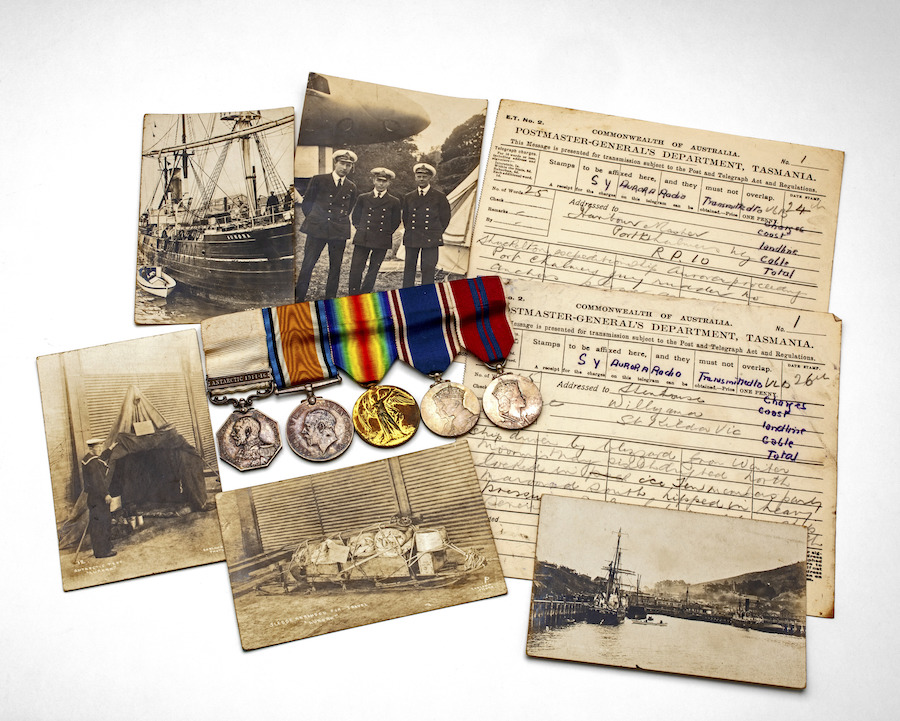
Telegrams sent by wireless operator Lionel Hooke to signal Aurora’s survival during the drift in March and April 1916. Medals awarded to Sir Lionel Hooke: Antarctic Medal and bar 1914–16; British War Medal 1914–18; ‘The Great War for Civilisation 1914–19’ Victory Medal; King George VI Coronation Medal 12 May 1937; Queen Elizabeth II. Australian National Maritime Museum Collection Gift from Maria Teresa Hooke OAM and her sons John Max and Paolo in memory of John Hooke CBE and Sir Lionel Hooke. Coronation Medal 2 June 1953, Photographs: Aurora on arrival Port Chalmers, New Zealand, 1916; Lionel Hooke at WWI Royal Naval Air Services base, Bude, UK; and with fellow officers and airship, 1918 – Australian National Maritime Museum Collection Gift from Maria Teresa Hooke OAM and her sons John Max and Paolo in memory of John Hooke CBE and Sir Lionel Hooke
The exhibition is presented with the support of the great-grandchildren of one of SY Aurora’s early Arctic masters, Captain James Fairweather, in memory of their father James S Fairweather (1926-2015).
Senior Curator Daina Fletcher said, ‘This small exhibition features a selection of historic objects donated to the National Maritime Collection from family members which will thrill visitors through the drama, ambition, expertise and poignancy they embody. Overall, the story of this vessel, SY Aurora, touches lives and keynotes from the early history of Antarctic exploration and Australia’s part in it, in expeditions, especially that of Sir Douglas Mawson, which contributed to Australia’s territorial claim to more than 42% of the continent in the Antarctic Treaty of 1959.’
Frozen Witness: Aurora’s Polar Voyages invites visitors to rediscover this remarkable vessel and the people whose lives were entwined with it. Their story is one of endurance, innovation, and the power of the human spirit in the face of the unknown.
- Free entry to permanent galleries
- School holiday hours, open 9:30am—5pm (Last vessel boarding 4:10pm)
- Regular hours, open 10am—4pm (Last vessel boarding 3:10pm)






